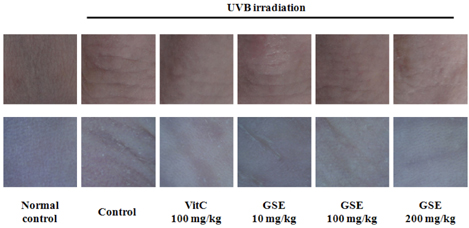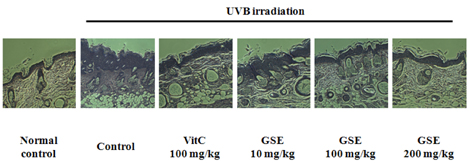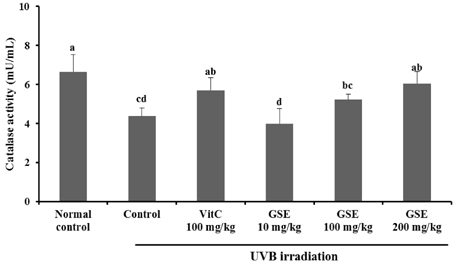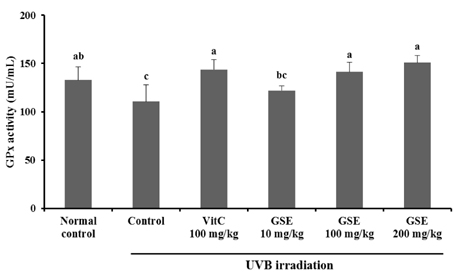Nutr Res Pract.
2014 Aug;8(4):398-403.
Protective effect of the standardized green tea seed extract on UVB-induced skin photoaging in hairless mice
- Affiliations
-
- 1Department of Biomaterials Science and Technology, Yonsei University, 50 Yonsei-ro, Seodaemun-gu, Seoul 120-749, Korea. jkhwang@yonsei.ac.kr
- 2Department of Medical Nutrition, Graduate School of East-West Science, Kyung Hee University, Yongin, Gyeonggi 446-701, Korea.
- 3NutriPlan Co., Ltd, Gyeonggi 410-837, Korea.
Abstract
- BACKGROUND/OBJECTIVES
Ultraviolet B (UVB) irradiation on skin can induce production of reactive oxygen species (ROS), which cause expression of matrix metalloproteinases (MMPs) and collagen degradation. Thus, chronic exposure of skin to UVB irradiation leads to histological changes consistent with aging, such as wrinkling, abnormal pigmentation, and loss of elasticity. We investigated the protective effect of the standardized green tea seed extract (GSE) on UVB-induced skin photoaging in hairless mice.
MATERIALS/METHODS
Skin photoaging was induced by UVB irradiation on the back of Skh-1 hairless mice three times per week and UVB irradiation was performed for 10 weeks. Mice were divided into six groups; normal control, UVB irradiated control group, positive control (UVB + dietary supplement of vitamin C 100 mg/kg), GSE 10 mg/kg (UVB + dietary supplement of GSE 10 mg/kg), GSE 100 mg/kg (UVB + dietary supplement of GSE 100 mg/kg), and GSE 200 mg/kg (UVB + dietary supplement of GSE 200 mg/kg).
RESULTS
The dietary supplement GSE attenuated UVB irradiation-induced wrinkle formation and the decrease in density of dermal collagen fiber. In addition, results of the antioxidant analysis showed that GSE induced a significant increase in antioxidant enzyme activity compared with the UVB irradiation control group. Dietary supplementation with GSE 200 mg/kg resulted in a significant decrease in expression of MMP-1, MMP-3, and MMP-9 and an increase in expression of TIMP and type-1 collagen.
CONCLUSIONS
Findings of this study suggest that dietary supplement GSE could be useful in attenuation of UVB irradiation-induced skin photoaging and wrinkle formation due to regulation of antioxidant defense systems and MMPs expression.
Keyword
MeSH Terms
Figure
Reference
-
1. Katiyar SK, Korman NJ, Mukhtar H, Agarwal R. Protective effects of silymarin against photocarcinogenesis in a mouse skin model. J Natl Cancer Inst. 1997; 89:556–566.
Article2. Limtrakul P, Suttajit M, Semura R, Shimada K, Yamamoto S. Suppressive effect of soybean milk protein on experimentally induced skin tumor in mice. Life Sci. 1993; 53:1591–1596.
Article3. Passi S, De Pità O, Grandinetti M, Simotti C, Littarru GP. The combined use of oral and topical lipophilic antioxidants increases their levels both in sebum and stratum corneum. Biofactors. 2003; 18:289–297.
Article4. Fisher GJ, Wang ZQ, Datta SC, Varani J, Kang S, Voorhees JJ. Pathophysiology of premature skin aging induced by ultraviolet light. N Engl J Med. 1997; 337:1419–1428.
Article5. Zhang X, Rosenstein BS, Wang Y, Lebwohl M, Wei H. Identification of possible reactive oxygen species involved in ultraviolet radiation-induced oxidative DNA damage. Free Radic Biol Med. 1997; 23:980–985.
Article6. Kovacs D, Raffa S, Flori E, Aspite N, Briganti S, Cardinali G, Torrisi MR, Picardo M. Keratinocyte growth factor down-regulates intracellular ROS production induced by UVB. J Dermatol Sci. 2009; 54:106–113.
Article7. Aquino R, Morelli S, Tomaino A, Pellegrino M, Saija A, Grumetto L, Puglia C, Ventura D, Bonina F. Antioxidant and photoprotective activity of a crude extract of Culcitium reflexum H.B.K. leaves and their major flavonoids. J Ethnopharmacol. 2002; 79:183–191.
Article8. Katiyar SK, Afaq F, Azizuddin K, Mukhtar H. Inhibition of UVB-induced oxidative stress-mediated phosphorylation of mitogen-activated protein kinase signaling pathways in cultured human epidermal keratinocytes by green tea polyphenol (-)-epigallocatechin-3-gallate. Toxicol Appl Pharmacol. 2001; 176:110–117.
Article9. Kawada S, Ishii N. Suppression of UVB-induced HIF-1α up-regulation by hyperoxia does not prevent wrinkle formation associated with increased MMPs activity in mouse skin. Biomed Res. 2011; 32:363–372.
Article10. Shephard P, Martin G, Smola-Hess S, Brunner G, Krieg T, Smola H. Myofibroblast differentiation is induced in keratinocyte-fibroblast co-cultures and is antagonistically regulated by endogenous transforming growth factor-beta and interleukin-1. Am J Pathol. 2004; 164:2055–2066.
Article11. Inomata S, Matsunaga Y, Amano S, Takada K, Kobayashi K, Tsunenaga M, Nishiyama T, Kohno Y, Fukuda M. Possible involvement of gelatinases in basement membrane damage and wrinkle formation in chronically ultraviolet B-exposed hairless mouse. J Invest Dermatol. 2003; 120:128–134.
Article12. Talwar HS, Griffiths CE, Fisher GJ, Hamilton TA, Voorhees JJ. Reduced type I and type III procollagens in photodamaged adult human skin. J Invest Dermatol. 1995; 105:285–290.
Article13. Fisher GJ, Voorhees JJ. Molecular mechanisms of photoaging and its prevention by retinoic acid: ultraviolet irradiation induces MAP kinase signal transduction cascades that induce Ap-1-regulated matrix metalloproteinases that degrade human skin in vivo. J Investig Dermatol Symp Proc. 1998; 3:61–68.
Article14. Ruch RJ, Cheng SJ, Klaunig JE. Prevention of cytotoxicity and inhibition of intercellular communication by antioxidant catechins isolated from Chinese green tea. Carcinogenesis. 1989; 10:1003–1008.
Article15. Zheng G, Sayama K, Okubo T, Juneja LR, Oguni I. Anti-obesity effects of three major components of green tea, catechins, caffeine and theanine, in mice. In Vivo. 2004; 18:55–62.16. Park JS, Rho HS, Kim DH, Chang IS. Enzymatic preparation of kaempferol from green tea seed and its antioxidant activity. J Agric Food Chem. 2006; 54:2951–2956.
Article17. Kim NH, Choi SK, Kim SJ, Moon PD, Lim HS, Choi IY, Na HJ, An HJ, Myung NY, Jeong HJ, Um JY, Hong SH, Kim HM. Green tea seed oil reduces weight gain in C57BL/6J mice and influences adipocyte differentiation by suppressing peroxisome proliferator-activated receptor-gamma. Pflugers Arch. 2008; 457:293–302.
Article18. Yoon WH, Choi JH, Lee KH, Kim CH. Antimicrobial and antitumor activities of seed extracts of Camellia sinensis L. Korean J Food Sci Technol. 2005; 37:108–112.19. Rah HH, Baik SO, Han SB, Bock JY. Chemical compositions of the seed of Korean green tea plant (Camellia sinecis L.). Agric Chem Biotechnol. 1992; 35:272–275.20. McArdle F, Rhodes LE, Parslew R, Jack CI, Friedmann PS, Jackson MJ. UVR-induced oxidative stress in human skin in vivo: effects of oral vitamin C supplementation. Free Radic Biol Med. 2002; 33:1355–1362.
Article21. Bowden GT. Prevention of non-melanoma skin cancer by targeting ultraviolet-B-light signalling. Nat Rev Cancer. 2004; 4:23–35.
Article22. Rittié L, Fisher GJ. UV-light-induced signal cascades and skin aging. Ageing Res Rev. 2002; 1:705–720.
Article23. Yaar M, Gilchrest BA. Skin aging: postulated mechanisms and consequent changes in structure and function. Clin Geriatr Med. 2001; 17:617–630. v24. Morganti P, Bruno C, Guarneri F, Cardillo A, Del Ciotto P, Valenzano F. Role of topical and nutritional supplement to modify the oxidative stress. Int J Cosmet Sci. 2002; 24:331–339.
Article25. Yamamoto Y. Role of active oxygen species and antioxidants in photoaging. J Dermatol Sci. 2001; 27:Suppl 1. S1–S4.
Article26. Okada K, Takahashi Y, Ohnishi K, Ishikawa O, Miyachi Y. Time-dependent effect of chronic UV irradiation on superoxide dismutase and catalase activity in hairless mice skin. J Dermatol Sci. 1994; 8:183–186.
Article27. Filip A, Daicoviciu D, Clichici S, Mocan T, Muresan A, Postescu ID. Photoprotective effects of two natural products on ultraviolet B-induced oxidative stress and apoptosis in SKH-1 mouse skin. J Med Food. 2011; 14:761–766.
Article28. Brennan M, Bhatti H, Nerusu KC, Bhagavathula N, Kang S, Fisher GJ, Varani J, Voorhees JJ. Matrix metalloproteinase-1 is the major collagenolytic enzyme responsible for collagen damage in UV-irradiated human skin. Photochem Photobiol. 2003; 78:43–48.
Article29. Philips N, Conte J, Chen YJ, Natrajan P, Taw M, Keller T, Givant J, Tuason M, Dulaj L, Leonardi D, Gonzalez S. Beneficial regulation of matrixmetalloproteinases and their inhibitors, fibrillar collagens and transforming growth factor-beta by Polypodium leucotomos, directly or in dermal fibroblasts, ultraviolet radiated fibroblasts, and melanoma cells. Arch Dermatol Res. 2009; 301:487–495.
Article30. Vayalil PK, Mittal A, Hara Y, Elmets CA, Katiyar SK. Green tea polyphenols prevent ultraviolet light-induced oxidative damage and matrix metalloproteinases expression in mouse skin. J Invest Dermatol. 2004; 122:1480–1487.
Article
- Full Text Links
- Actions
-
Cited
- CITED
-
- Close
- Share
- Similar articles
-
- Effects of PB203 on the skin photoaging of ultraviolet B (UVB)-irradiated hairless mice and human keratinocytes
- Dietary effect of green tea extract on epidermal levels of skin pH related factors, lactate dehydrogenase protein expression and activity in UV-irradiated hairless mice
- Photoprotective Effect of Various Sunscreens Against Ultraviolet B - induced Chronic Skin Damage
- Evaluation of the Anti-inflammatory Effect of a Moisturizer Containing Green-Tea Extracts
- The Effects of UVB Irradiation and Sunscreen Agents on Photoaging of Hairless Albino Mouse Skin






